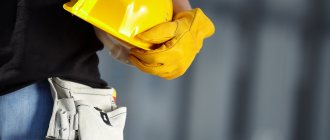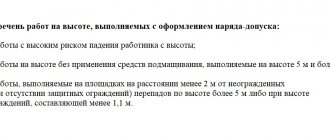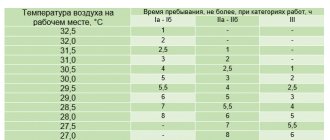On January 1, 2021, new rules for working at height came into force. We propose to trace the main changes in this area of hazardous work. (For the rest of the changes in labor protection rules from January 2021, see our article).
The document that consolidated these changes is the order of the Ministry of Labor and Social Protection of the Russian Federation dated November 16, 2020. No. 782n “On approval of the Labor Safety Rules when working at heights.”
Therefore, the orders in force up to this point are cancelled:
- No. 155n dated March 28, 2014 “On approval of labor protection rules when working at height”
- No. 383n dated June 17, 2015 “On amendments to the Labor Safety Rules when working at heights”
New Rules No. 782n are introduced for 5 years (until December 31, 2025). They can then be revised or canceled if necessary.
Such changes were necessary and expected. Our government is carrying out a reform of control and supervisory activities. The direction of this reform was approved in 2021. The task is the transition from comprehensive control (supervision) to differentiated control taking into account risks. The essence of a risk-based approach in any area is that control increases in high-risk areas, and decreases or is absent in safer areas. This allows you to take the necessary measures in a timely manner where it is required and significantly save resources.
Rules No. 782n are developed taking into account modern government guidelines and a risk-based approach to monitoring work at height. Here, inaccuracies have been eliminated and those issues that caused ambiguous interpretation when organizing work at height according to Rules No. 155n have been refined. The changes affected almost all sections of the Labor Safety Rules when working at height, valid until January 1, 2021.
Let's look at the changes in more detail using the example of paragraphs of Rules No. 782n.
We offer a comparative table for key sections, which shows the main differences between the new edition No. 782n and Rules No. 155n.
Here's what it looks like section by section.
General provisions
In the first section, the new Rules on labor protection when working at height draw the employer's attention to risk assessment in the control of work at height and the development of an occupational safety and health system in the form of separate regulations. This is reflected in points 4 and 6, which now look different.
An occupational safety and health management system (OSMS) is a set of interrelated and interacting elements that establish policies and goals in the field of occupational safety for a particular employer and procedures for achieving these goals. (Article 209 “Labor Code of the Russian Federation” dated December 30, 2001 N 197-FZ
Read more about the occupational safety management system at the enterprise.
In the previous version of the Rules, paragraph 6 prescribed mandatory medical examinations for workers at height. Both upon entry to work (preliminary) and periodic medical examinations. This requirement is excluded from the new Rules.
The changes affected the registration of the permit. This is reflected in paragraphs 7 and 8 of Rules No. 782n.
Rules No. 155n (clause 11) listed work at height, which the employer is obliged to organize with the issuance of a permit. And paragraph 21 of Rules No. 155n was supplemented with requirements for issuing a permit for work at height in non-stationary places. In the new Rules, paragraphs of similar meaning have been revised and supplemented with an assessment of the risk of work.
The important difference here is that in Rules No. 155n (clause 11), the issuance of a work permit was determined by the group into which workers for the safety of work at height are divided. Now it is necessary to make a decision on issuing a work permit based on an assessment of the risk of a worker falling. According to the new Rules, for work with an acceptable minimum risk, a work permit may not be issued. This must be periodically repeated work, which is distinguished by the constancy of the place, conditions and nature of the work, collective protective equipment, is part of the technological process and is performed by a permanent staff of qualified performers.
Clause 9 of Rules No. 782n is new and concerns document flow in the field of labor protection. Allows for electronic document management in the field of labor protection. This clarification significantly reduces the burden on the manager of maintaining paper documentation at the enterprise.
Clause 11 establishes the scope of application of the new Rules, including in the design of facilities and the development of technological processes.
Requirements for workers when working at height
In the second section, attention is paid to the qualifications, education and training of workers who take part in the organization and execution of work. The areas of responsibility of all participants in these works are delimited.
Workers who are allowed to directly perform work at height, carried out under a work permit, are, as before, divided into three work safety groups. The difference is that Rules No. 782n clearly indicate the division into employees who directly perform work at height and responsible persons. And separately, in paragraph 15, an important clarification was added about workers of group 3. Now the rules for working at height indicate the admission of this group of workers to the direct performance of work, but only subject to confirmation of qualifications and receipt of a certificate for the corresponding group.
The new version of the Labor Safety Rules when working at height for 2021 (Order No. 782n) establishes a ban on conducting training in safe methods and techniques for performing work at height in correspondence (distance) form. This prohibition is noted in paragraph 17, which also specifically mentions self-training internships, which are also now prohibited.
In the same section, paragraph 29 again deals with employee internships.
The responsibilities of employees of group 3 are explained in detail, the requirements for internship and periodic testing of knowledge of this group are clarified. The periodic testing of knowledge of employees of group 3 is noted in paragraph 33 of Rules No. 782n.
Document structure
The safety rules for working at height cover all the main aspects of organizing such activities. In this regard, the document includes the following information blocks:
- general provisions containing types of work differentiated by production conditions;
- occupational safety requirements for organizing and performing production operations;
- requirements for production premises and sites;
- procedure for applying personnel safety systems;
- special requirements for organizing work using professional structures, including rope access systems, stairs and ladders, rigid and flexible anchor lines, etc.
In addition to the main appendix containing the rules for safe production activities, the order is also provided with additional appendices. They provide samples of documents used in organizing work, including a certificate of admission to high-altitude operations, a work permit, an employee’s personal record book, a log of completed tasks, etc. Particular attention in the appendices to the order is paid to the operation of anchor systems. In addition to describing the rules for their use and standard values for the parameters of such systems, graphic diagrams are provided here that explain the mechanisms for fastening structures and other features of their use.
Groups of high-altitude work
To differentiate the powers of employees allowed to perform high-altitude work, taking into account their qualifications and necessary skills, Order No. 155n introduces the concept of a safety group. In total, the document identifies three such groups:
- 1 – employees who are allowed to perform production operations as part of a team or under the guidance of an experienced worker;
- 2 – experienced team leaders, foremen, internship organizers, as well as employees allowed to carry out work under a work permit;
- 3 – responsible employees appointed by the employer to conduct internships, briefings, organize work, develop a plan for evacuation of personnel in emergency situations, etc. This category also includes specialists involved in training employees and members of certification commissions.
Employees of all groups are required to undergo regular training to improve their skills. Employees of groups 1 and 2 undergo training at least once every 3 years, and employees of groups 4 - at least once every 5 years.
Requirements for the use of safety systems for working at height
The scheme for providing workers with personal protective equipment (PPE) against falls from a height can be divided into 2 types:
- Personal PPE – issued directly to the employee.
- PPE on duty workers are assigned to a specific workplace and are on duty. They are not permanently assigned to one employee, but are transferred from one shift to another.
Such a system for issuing PPE was not previously described in Rules No. 155n. As amended by the Rules on Labor Safety when Working at Height dated January 1, 2021, paragraph 122 was added, which describes the procedures for issuing duty PPE. The main thing to remember is that only PPE with an operation indicator can be used as duty PPE.
This section also adds a requirement for anchor devices used in security systems.
Previously, there were several conflicting requirements for anchor devices. Rules No. 155n established requirements for the strength of such devices. At the same time, the strength of anchor devices in the restraint systems and safety systems differed (13.3 kN versus 22 kN).
It is known that on the territory of the Customs Union there is Technical Regulation of the Customs Union No. 019/2011 “On the safety of personal protective equipment”, which establishes requirements for such anchor devices. Certification tests are carried out according to the methods of GOST EN 795-2014 and GOST EN/TS 16415-2015, which set requirements for the strength of anchor devices at 15 kN.
Existing contradictions are eliminated in Rules No. 782n. Now the Rules stipulate that anchor devices are subject to mandatory certification (clause 129).
The new paragraph - 145 gives freedom in choosing anchor devices taking into account their characteristics.
A new provision on structural anchor has been included (clause 128); in the previous version of the Rules there was no such term.
Structural anchor - an element or elements permanently attached to a structure (building) so that an anchor device or personal protective equipment can be attached to it. GOST EN 795-2014 “System of occupational safety standards (OSSS). Personal protective equipment against falls from height. Anchor devices. General technical requirements. Test methods")
Whereas previously anchoring locations were specified in the work plan at height and were determined primarily based on site inspections, the development of these plans may now require confirmation of the strength of structural anchors through strength calculations.
Requirements for enterprises
The NP supplements the requirements for labor protection enterprises for work at height:
- The following preparatory measures are mandatory:
- approval of the work plan before it begins;
- preparation of detailed technical documentation for the processes and stages of work being performed;
- approval of the list of those responsible for work safety.
- Determine the boundaries of responsibility for participants in the work:
- those issuing permits (3rd group) are responsible for the correctness of their issuance and for ensuring labor protection and safety requirements;
- work managers (3rd group) are responsible for: obtaining permits, staffing the working group with all the required means and devices, targeted instruction, compliance with all safety measures according to the work plan;
- responsible executors (2nd group) - are responsible for the actual performance of work: they personally coordinate the entire process, starting from the removal of authorized workers to the work site and ending with their removal from the site at the end of the shift;
- performers of work (1st group) - are responsible for strictly following all the requirements received during the briefing, for constant contact with the responsible contractor during the work and following only his instructions, for knowing the procedure for handling equipment, equipment and means of insurance and protection.
- The set of requirements for ensuring the safety of work at height is updated. Separate POT requirements relating to:
- insurance systems;
- personal and collective protective equipment;
- construction and installation works of certain types
in the NP were combined and clarified in such a way that they became as close as possible to SNiP 12-04-2002 “Labor safety in construction. Part 2".
Find out more about the certification of workplaces with special working conditions from the article “ Certification of workplaces according to working conditions - procedure and terms . ”
IMPORTANT! The NP removed the requirements for fencing of work sites (they remained in SNiP 12-03-2001 “Occupational Safety in Construction. Part 1”) and simplified the requirements for the use of ladders, ladders and similar means of ascent and descent.
Labor protection requirements when working on antenna mast structures
The Rules for Labor Safety when Working at Height, as amended by Order No. 782n, eliminate strict restrictions when working on antenna mast structures when the voltage is not removed and in difficult weather conditions. Clause 297 establishes compliance with a number of conditions necessary to carry out such work.
In northern climate zones, antenna mast structures and other objects are constantly covered in ice, so previously we had to face some difficulties when working at height. The new requirements give more freedom of action for the work organizer, but do not relieve the employer of responsibility for organizing and observing safety measures for working at height in special conditions.
These are the main changes to the Labor Safety Rules when working at height, Order No. 782n, which affected the most frequently used topics during such work. The full version of the new Rules No. 782n can be found at the link, order of the Ministry of Labor and Social Protection of the Russian Federation dated November 16, 2020. No. 782n “On approval of the Labor Safety Rules when working at heights”
Important!
When new labor protection rules are introduced, all employees of organizations, regardless of their organizational and legal form of activity, must undergo an extraordinary knowledge test (clause 3.3 of Procedure 1/29)
Resolution of the Ministry of Labor of the Russian Federation and the Ministry of Education of the Russian Federation of January 13, 2003 N 1/29 “On approval of the Procedure for training in labor protection and testing knowledge of labor protection requirements for employees of organizations” (with amendments and additions)
Document status
The order we are interested in came into force in 2014, six months after the date of its official publication. Now it has active status. At the same time, during the period of its application, changes were made to the text of the document twice, aimed at achieving compliance of its requirements with the current situation in the production sector. This happened in 2015 and 2021. The corresponding changes were approved by orders of the Ministry of Labor dated June 17, 2015 N 383n and dated December 20, 2021 N 826n.
The main part of the document is the first appendix to it, which contains rules for ensuring labor safety when performing work at height. They are mandatory for all employees of enterprises, as well as employers, regardless of their organizational and legal form, company size, field of activity and other factors. At the same time, to increase the level of safety of their employees, organizations can establish additional rules that do not conflict with the provisions of the order we are interested in, as well as other legal acts, including the Labor Code of the Russian Federation.







